Salesforce is an excellent tool for tracking information about constituents, programs, fundraising, and so much more. But when you want to add marketing functionality to your toolbox, you need to venture beyond standard Salesforce and take a look at other tools. If you’re wondering what the Salesforce Marketing Cloud is, and whether it could help your organization, this post is for you!
Salesforce Marketing Cloud helps you communicate with your constituents through multiple channels, including email, mobile, social, ads, and web. It also includes marketing automation tools that allow you to build cross-channel journeys for your constituents to follow.
Over time, Salesforce has added features and functionality to the Marketing Cloud, partially by acquiring other products and adding them to Marketing Cloud. Some of its documentation and styling reflects this building-block approach and can feel a bit disjointed. Over time, Salesforce is updating the user interface, documentation, and functionality to make this package of tools feel less like an assortment of different things, and more like a seamless, unified platform. The Marketing Cloud carries a price tag, but it includes the functionality to demand the price. It is a great tool for organizations that want to engage with a broad base of constituents in philanthropy or advocacy.
There are many tools available on the AppExchange, so why would you choose the Marketing Cloud as opposed to one of the others? Salesforce Pardot has a lot of the same functionality, including marketing automation. The main difference between the two is that Pardot only includes email and web, whereas the Marketing Cloud is a true cross-channel platform, with email, mobile, social, and web. Pardot is geared toward business-to-business (B2B) marketing, whereas the Marketing Cloud excels with business-to-consumer (B2C) marketing.
All of this makes more sense when you get a feel for what this product can do. Let’s jump in and take a look at some of the fun tools within the Marketing Cloud.
Journey Builder

Journey Builder is one of the coolest parts of the Marketing Cloud. Right now, what happens when someone donates to your organization for the first time? They probably get a thank-you email or letter, and perhaps that donor is added to your newsletter list so they receive future updates. With Journey Builder, you can make these communications much more personal and nuanced by designing a series of messages that are responsive to the donor’s interaction with your organization.
For example, your new donor gets a welcome email with a link to sign up for the e-Newsletter. If they don’t sign up within 3 days, they get a friendly reminder. Once they sign up, you send a welcome message asking which programs they’re interested in learning about further. A few days later, they get a message with volunteer opportunities related to those programs. All of this rich interaction is happening automatically, so after you set it up, it keeps running for each new donor who gives to your organization. Since Marketing Cloud includes social and mobile channels, you can add text messages and social media ads to your Journey, too, allowing you to communicate with your constituents the way they want to communicate with you – in a connected, integrated way.
Email Marketing
The email tool in the Marketing Cloud allows you to design and schedule messages to targeted groups of constituents, either through Journey Builder, or as a mass email message. You can store content like images, text blocks, and videos, in your portfolio to be used (or re-used) in different messages. What really makes this email tool stand out is a feature called Dynamic Content. With Dynamic Content, you can send unique and customized email messages, even in a mass-send. For instance, you could filter your email list on the subscriber’s main area of interest, and then send them a newsletter that highlights your programs that are of the greatest importance to the subscriber. Dynamic Content allows you to populate a content box with different images and text, depending on information you have about the recipient of the message.
Geofencing
Email is just the beginning of what you can do with Marketing Cloud. There are also some great mobile engagement tools. With geofencing, you can trigger a mobile push message to your constituent’s phone, based on their geographic location. This tool has some exciting applications for large-scale events, like advocacy demonstrations, conferences, or fundraising events. If your organization is hosting a large fundraising run/walk event, you can trigger a message as they approach to welcome them, let them know where to sign in, and what time the run starts. It’s another way to give your constituents a personal experience with your organization.
Social Studio
The Marketing Cloud has also added social listening and engagement tools called Social Studio. Social Studio includes two tools: Publish, which allows you to schedule and publish content to multiple social media channels; and Engage, which allows you to monitor activity on your social media accounts, as well as in the wider social media universe. Social Studio does everything that its free counterparts (like HootSuite or TweetDeck) can do, but it has functionality that allows you to manage more complex social communication. This tool is a great fit for larger organizations, like universities, that want to manage an integrated, responsive social media presence across multiple schools or departments.
Salesforce Connector
The tools that are part of Marketing Cloud generate rich data about your constituents. With the Salesforce Marketing Cloud Connector, you can connect the Marketing Cloud with Salesforce, eliminating data silos and creating a seamless view of your programs and people.
If you feel stuck with your current marketing tools, the Marketing Cloud may be the right next step for your organization!
More posts you may be interested in:





